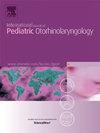Development and evaluation of a combined fluency rules program (FRP) with parent-child interaction training for preschool children who stutter: A randomized controlled trial
IF 1.2
4区 医学
Q3 OTORHINOLARYNGOLOGY
International journal of pediatric otorhinolaryngology
Pub Date : 2025-01-01
DOI:10.1016/j.ijporl.2024.112189
引用次数: 0
Abstract
Introduction
This study aimed to develop and evaluate the effectiveness of a combined Fluency Rules Program (FRP) with parent-child interaction training for preschool children with stuttering.
Methods
A randomized controlled trial was conducted with 49 preschool children who stuttered. Participants were randomly assigned to either the experimental group, which received the combined FRP with parent-child interaction training, or the control group, which received only the FRP. Both groups attended 45-min therapy sessions twice weekly for three months.
Results
According to the change score analysis, at posttest measurement, there were significant decreases in the stuttering severity scores in both groups, but intervention group had a greater decrease than control group (mean differences = 4.50, 95 % CI [3.55 to 5.45], P < 0.001). The improvement (i.e., increase) in the “Severity of Stuttering and Impact on the Parents” scores in the intervention group was 1.49 (95 % CI [1.10 to 1.89], P < 0.001) points higher than the control group. The similar result was obtained for “Parent's Knowledge and Confidence in Managing it” factor. There was no statistically significant difference in the “Impact of Stuttering on the Child” scores between control and intervention groups (P = 0.163).
Conclusion
The combined FRP with parent-child interaction training was more effective than the FRP alone in reducing the severity of stuttering and improving parental confidence.
学龄前口吃儿童流利规则计划与亲子互动训练相结合的发展与评价:一项随机对照试验。
前言:本研究旨在开发和评估流利规则计划(FRP)与亲子互动训练相结合对学龄前口吃儿童的有效性。方法:对49例学龄前口吃儿童进行随机对照试验。参与者被随机分配到实验组和对照组,实验组接受FRP结合亲子互动训练,对照组只接受FRP。两组都参加了为期三个月的治疗,每周两次,每次45分钟。结果:根据变化评分分析,在测试后测量中,两组的口吃严重程度评分均有显著下降,但干预组的下降幅度大于对照组(平均差异= 4.50,95% CI [3.55 ~ 5.45], P)。结论:FRP联合亲子互动训练在降低口吃严重程度和提高父母信心方面比单独FRP更有效。
本文章由计算机程序翻译,如有差异,请以英文原文为准。
求助全文
约1分钟内获得全文
求助全文
来源期刊
CiteScore
3.20
自引率
6.70%
发文量
276
审稿时长
62 days
期刊介绍:
The purpose of the International Journal of Pediatric Otorhinolaryngology is to concentrate and disseminate information concerning prevention, cure and care of otorhinolaryngological disorders in infants and children due to developmental, degenerative, infectious, neoplastic, traumatic, social, psychiatric and economic causes. The Journal provides a medium for clinical and basic contributions in all of the areas of pediatric otorhinolaryngology. This includes medical and surgical otology, bronchoesophagology, laryngology, rhinology, diseases of the head and neck, and disorders of communication, including voice, speech and language disorders.

 求助内容:
求助内容: 应助结果提醒方式:
应助结果提醒方式:


